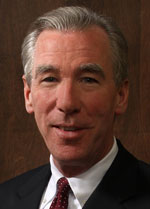In January, The Chronicle of Higher Education ran a special issue about a federal program to promote healthy marriages, run by the U.S. Department of Health and Human Services.
The “HHS family of agencies,” as it likes to call itself, comprises 11 operating divisions and 10 regional offices. One of these is the Office of Family Assistance, which runs (among other things) the Healthy Marriage Initiative. It’s hard to say exactly how much the initiative costs, but it has about $60 million in grants outstanding.
Here’s how it works. Recruiters seek out poor parents, in places like hospitals and food-stamp offices, and offer them money and other inducements to attend 13 weeks of relationship education. Everyone agrees that children are better off with doting parents who love each other. The program aims to create families like this. A mere $60 million is small potatoes for an agency like HHS, but it comes to about $11,000 per couple for the program participants.
The results have been quite disappointing. A three-year study of eight grantees found that couples who took part were no more likely to stay together or get married than the control group. Fathers did not spend more time with children. Children were not more emotionally secure. Some programs actually showed negative outcomes, which is to say, the control group did better. The article in the Chronicle article asks, “So why aren’t we pulling the plug?”
[hotblock]
It doesn’t seem unreasonable to spend money to encourage young parents to marry and stay married. However ineffective this program has been, it does focus on a principal cause of the ills that afflict children and families. Consider the much-discussed problem of growing economic inequality. A new study by Harvard economist Raj Chetty indicates that the best predictor of economic mobility is the percentage of children who live in intact families.
The program’s failure is more disappointing still because it is that rare solution that can claim bipartisan support. Presidents Bush and Obama have both been fans.
Then again, isn’t it odd that we have engaged the federal government to teach young people about healthy marriage and relationship skills? I don’t just mean “odd” in a constitutional or political sense. I mean “odd” because HHS, as an institution, knows so little about love and marriage.
In the past we learned about those things from our families, our churches, parochial schools and a dozen other private associations. Today we look to Washington.
I am reminded of the passage in “Democracy in America” where Alexis de Tocqueville speaks about the progress of the temperance movement: “I came to understand,” he says, “that these hundred thousand Americans, frightened by the progress of drunkenness around them, wanted to support sobriety by their patronage. … One may fancy that if they had lived in France each of these hundred thousand would have made individual representations to the government asking it to supervise all the public houses throughout the realm.”
These days, we’re more like France.
Private institutions and individuals will always understand love, marriage, child rearing and families better than the government does.
Remitting to them the task of restoring marriage asks each of us to contribute a lot of arduous and unpaid work. That may explain the appeal of asking the government to manage our relationships. But — no surprise — the evidence indicates that that doesn’t work.
***
Garvey is president of The Catholic University of America in Washington.
PREVIOUS: A church of ‘yes’ may emerge from a church of ‘no’
NEXT: Now’s the time to plan for retirement, not just financially




Share this story